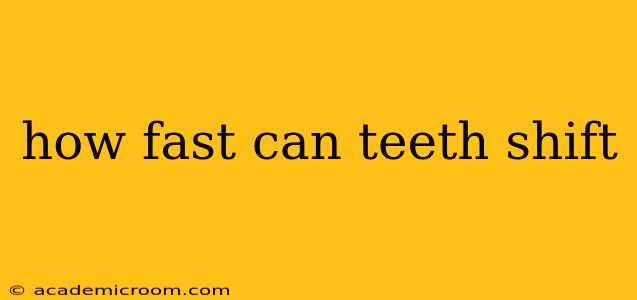The speed at which teeth shift depends on several factors, making it impossible to give a single definitive answer. While some individuals might see noticeable changes within weeks, others may require months or even years to achieve their desired results. Understanding the intricacies of tooth movement is key to managing expectations and ensuring a successful orthodontic journey.
How Long Does it Take for Teeth to Move?
The timeframe for tooth movement varies greatly depending on several key elements:
-
The severity of the malocclusion: Minor crowding or spacing issues may respond more quickly than complex cases requiring significant jaw realignment. A simple adjustment might take just a few months, whereas severe misalignment could necessitate several years of treatment.
-
The type of orthodontic treatment: Traditional braces often require a longer treatment period compared to clear aligners, which can sometimes offer faster results in less complex cases. However, even with aligners, treatment duration still depends on the individual's unique circumstances.
-
The patient's age and overall health: Younger individuals often experience faster tooth movement than adults. Underlying health conditions can also impact the speed of bone remodeling, which is crucial for tooth movement.
-
The type of appliance used: Different orthodontic appliances exert different levels of force on the teeth. Some appliances may deliver faster results, though this does not necessarily mean they're better.
What Factors Influence the Speed of Tooth Movement?
Several factors can significantly influence how quickly your teeth move:
-
Bone density: Individuals with denser bone may experience slightly slower tooth movement. The bone needs to remodel to accommodate the shifting teeth, and denser bone takes longer to reshape.
-
Compliance with the treatment plan: Diligent adherence to the orthodontist's instructions, including wearing retainers as directed, is crucial for ensuring consistent tooth movement and preventing relapse.
-
Oral hygiene: Maintaining excellent oral hygiene helps prevent complications that could slow down treatment. Infections or gum disease can interfere with the bone remodeling process, delaying progress.
What is the Average Time for Teeth to Move?
There isn't a universally applicable average timeframe. However, as a general guideline:
-
Minor adjustments: Might see noticeable changes within a few months.
-
Moderate corrections: Typically take 1-2 years.
-
Complex cases: May require 2-3 years or even longer.
Remember, these are just estimates, and your individual experience will vary.
Can Teeth Move Quickly with Invisalign?
Invisalign, and other clear aligner systems, can offer relatively faster tooth movement in certain cases, especially minor ones. However, the speed of movement still depends on the individual's specific circumstances and the complexity of their malocclusion. The advertised speed is often an average and not a guarantee.
How Long Does it Take to See Results with Braces?
Traditional braces treatment times are generally longer than clear aligner treatments, often ranging from 18 months to three years or more, depending on the complexity of the case.
How Can I Speed Up My Tooth Movement?
While you can't significantly expedite the natural process of tooth movement, maintaining excellent oral hygiene, strictly adhering to your orthodontist's instructions, and attending all scheduled appointments are essential for maximizing the efficiency of your treatment.
What Happens If My Teeth Move Too Fast?
Rapid tooth movement can increase the risk of root resorption (loss of tooth root structure). This is why orthodontists carefully manage the forces applied to the teeth. If movement is too fast, complications such as pain and inflammation can also arise. Your orthodontist will closely monitor your progress to ensure the movement is at a safe and effective pace.
Remember to always consult with your orthodontist for personalized advice and accurate timelines. They can provide a realistic assessment of your treatment duration based on your specific needs and condition.
